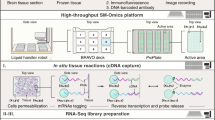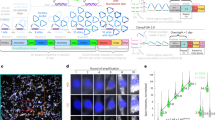Abstract
We present a protocol for visualizing and quantifying single mRNA molecules in mammalian (mouse and human) tissues. In the approach described here, sets of about 50 short oligonucleotides, each labeled with a single fluorophore, are hybridized to target mRNAs in tissue sections. Each set binds to a single mRNA molecule and can be detected by fluorescence microscopy as a diffraction-limited spot. Tissue architecture is then assessed by counterstaining the sections with DNA dye (DAPI), and cell borders can be visualized with a dye-coupled antibody. Spots are detected automatically with custom-made software, which we make freely available. The mRNA molecules thus detected are assigned to single cells within a tissue semiautomatically by using a graphical user interface developed in our laboratory. In this protocol, we describe an example of quantitative analysis of mRNA levels and localization in mouse small intestine. The procedure (from tissue dissection to obtaining data sets) takes 3 d. Data analysis will require an additional 3–7 d, depending on the type of analysis.
This is a preview of subscription content, access via your institution
Access options
Subscribe to this journal
Receive 12 print issues and online access
$259.00 per year
only $21.58 per issue
Buy this article
- Purchase on Springer Link
- Instant access to full article PDF
Prices may be subject to local taxes which are calculated during checkout





Similar content being viewed by others
References
Femino, A.M., Fay, F.S., Fogarty, K. & Singer, R.H. Visualization of single RNA Transcripts in situ. Science 280, 585–590 (1998).
Raj, A., van den Bogaard, P., Rifkin, S.A., van Oudenaarden, A. & Tyagi, S. Imaging individual mRNA molecules using multiple singly labeled probes. Nat. Methods 5, 877–879 (2008).
Itzkovitz, S. et al. Single-molecule transcript counting of stem-cell markers in the mouse intestine. Nat. Cell Biol. 14, 106–114 (2012).
Itzkovitz, S., Blat, I.C., Jacks, T., Clevers, H. & van Oudenaarden, A. Optimality in the development of intestinal crypts. Cell 148, 608–619 (2012).
Muñoz, J. et al. The Lgr5 intestinal stem cell signature: robust expression of proposed quiescent '+4' cell markers. EMBO J. 31, 3079–3091 (2012).
Van Es, J.H. et al. A critical role for the Wnt effector Tcf4 in adult intestinal homeostatic self-renewal. Mol. Cell Biol. 32, 1918–1927 (2012).
Guo, W. et al. Slug and Sox9 cooperatively determine the mammary stem cell state. Cell 148, 1015–1028 (2012).
Barker, N. et al. Lgr5+ve stem/progenitor cells contribute to nephron formation during kidney development. Cell Rep. 2, 540–552 (2012).
Bienko, M. et al. A versatile genome-scale PCR-based pipeline for high-definition DNA FISH. Nat. Methods 10, 122–124 (2013).
Levesque, M.J. & Raj, A. Single-chromosome transcriptional profiling reveals chromosomal gene expression regulation. Nat. Methods 10, 246–248 (2013).
Levsky, J.M., Shenoy, S.M., Pezo, R.C. & Singer, R.H. Single-cell gene expression profiling. Science 297, 836–840 (2002).
Snippert, H.J. et al. Intestinal crypt homeostasis results from neutral competition between symmetrically dividing Lgr5 stem cells. Cell 143, 134–144 (2010).
Itzkovitz, S. & van Oudenaarden, A. Validating transcripts with probes and imaging technology. Nat. Methods 8, S12–S19 (2011).
Levsky, J.M. & Singer, R.H. Fluorescence in situ hybridization: past, present and future. J. Cell Sci. 116, 2833–2838 (2003).
Emmert-Buck, M.R. et al. Laser-capture microdissection. Science 274, 998–1001 (1996).
Larsson, C., Grundberg, I., Söderberg, O. & Nilsson, M. In situ detection and genotyping of individual mRNA molecules. Nat. Methods 7, 395–397 (2010).
Morin, R. et al. Profiling the HeLa S3 transcriptome using randomly primed cDNA and massively parallel short-read sequencing. BioTechniques 45, 81–94 (2008).
Sultan, M. et al. A global view of gene activity and alternative splicing by deep sequencing of the human transcriptome. Science 321, 956–960 (2008).
Tang, F., Lao, K. & Surani, M.A. Development and applications of single-cell transcriptome analysis. Nat. Methods 8, S6–S11 (2011).
Lubeck, E. & Cai, L. Single-cell systems biology by super-resolution imaging and combinatorial labeling. Nat. Methods 9, 743–748 (2012).
Kilkenny, C, Browne, W.J., Cuthill, I.C., Emerson, M. & Altman, D.G. Improving bioscience research reporting: the ARRIVE guidelines for reporting animal research. PLoS Biol. 8, e1000412 (2010).
Maronpot, R.R., Boorman, G.A. & Gaul, B.W. Pathology of the Mouse: Reference and Atlas (Cache River Press, 1999).
Cook, M.J. The Anatomy of the Laboratory Mouse (Academic Press, 1965).
Carpenter, A.E. et al. CellProfiler: image analysis software for identifying and quantifying cell phenotypes. Genome Biol. 7, R100 (2006).
Author information
Authors and Affiliations
Contributions
A.v.O. supervised the project. A.L., S.I. and J.P.J. developed the protocol. X.W. and Z.P.F. contributed to software development. A.L., S.I., J.P.J. and A.v.O. wrote the paper.
Corresponding author
Ethics declarations
Competing interests
The authors declare no competing financial interests.
Supplementary information
Supplementary Table 1
Sequences of the target mRNAs and probe oligonucleotide probe libraries used in the example experiment. (PDF 162 kb)
Rights and permissions
About this article
Cite this article
Lyubimova, A., Itzkovitz, S., Junker, J. et al. Single-molecule mRNA detection and counting in mammalian tissue. Nat Protoc 8, 1743–1758 (2013). https://doi.org/10.1038/nprot.2013.109
Published:
Issue Date:
DOI: https://doi.org/10.1038/nprot.2013.109
This article is cited by
-
Antiviral responses are shaped by heterogeneity in viral replication dynamics
Nature Microbiology (2023)
-
The cellular states and fates of shed intestinal cells
Nature Metabolism (2023)
-
On-microscope staging of live cells reveals changes in the dynamics of transcriptional bursting during differentiation
Nature Communications (2022)
-
Single-cell profiling of vascular endothelial cells reveals progressive organ-specific vulnerabilities during obesity
Nature Metabolism (2022)
-
A spatiotemporally resolved single-cell atlas of the Plasmodium liver stage
Nature (2022)
Comments
By submitting a comment you agree to abide by our Terms and Community Guidelines. If you find something abusive or that does not comply with our terms or guidelines please flag it as inappropriate.



